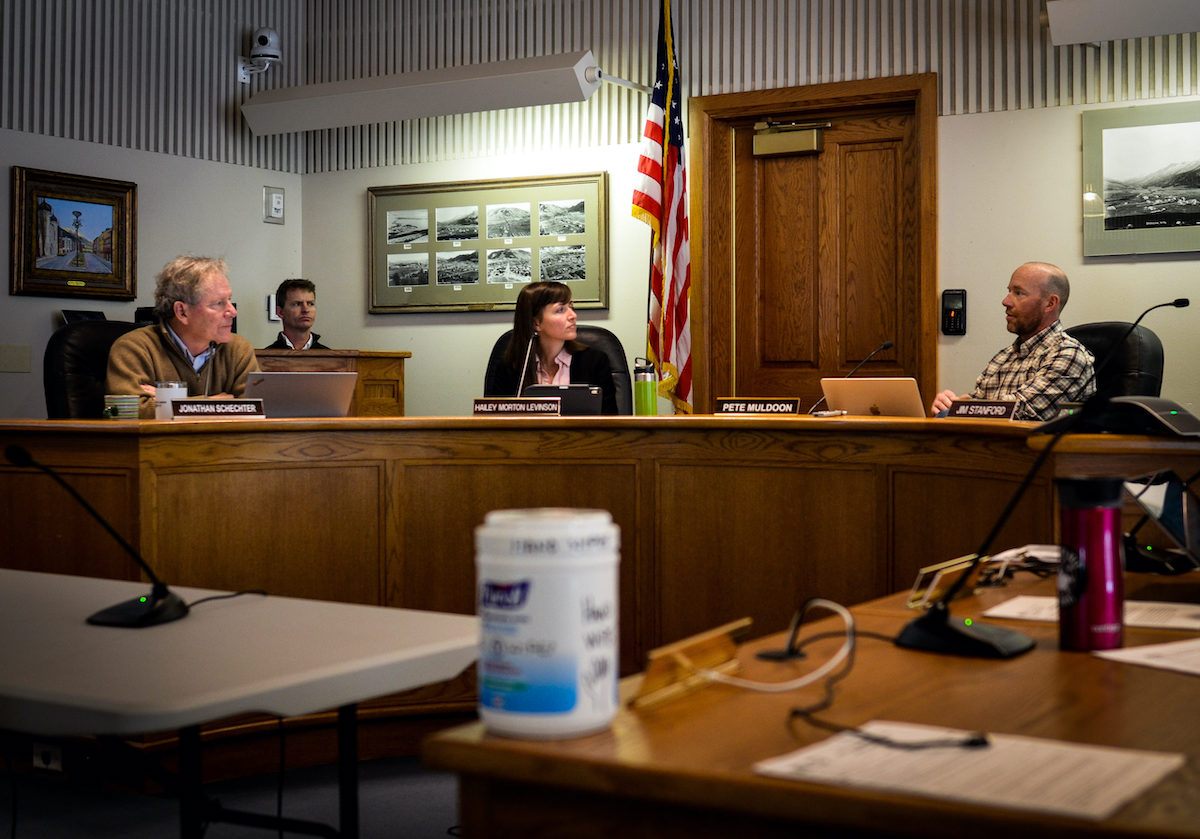Many in Jackson have already slipped into quarantine mode, those who haven’t must now stay home.
Following two emergency sessions in as many days, Jackson Town Council unanimously passed a stay-at-home ordinance to slow the spread of COVID-19 and help safeguard the valley’s limited medical infrastructure. The order is in effect until April 17, the same expiration date for statewide closures and limited gatherings.
“How the virus moves through the community is largely dependent on what we do,” Mayor Pete Muldoon said. He urged people “to respect” the string of measures that local and state officials recently passed to flatten the curve.
The move drew at least a dozen public comments both in support and against it. Some worried an order that excluded areas outside the town’s jurisdiction would be largely ineffective. Others, meanwhile, urged councilors to pass the ordinance without delay. “Please take strong action,” Nancy Turner Steveson wrote. “The hospital situation is terrifying. What if, what if, what if…”
Under the ordinance, people experiencing homelessness and victims of domestic abuse are exempt. All others must only leave their homes for “essential activities.” The ordinance outlines five such categories.
Health and safety reasons are allowed, such as visiting a doctor or pharmacy. People can also go out to buy groceries and supplies and for physical exercise. The latter comes under the provision that folks maintain six feet of social distance.
Jackson residents are also allowed to leave their homes to care for people or pets in another household. Finally, essential workers are exempt and people that maintain fundamental operations for any business.
Jackson Chief of Police Todd Smith told councilors Friday that the measure was a tool to encourage good behavior. For example, it would prevent employers from forcing workers to clock in during the pandemic. Still, Smith said he won’t enforce it. Its main function, he said, is to send a strong message.
That message, according to Muldoon: “This is serious.”
Before voting, the mayor issued a plea for everyone to support actions that will protect the community’s vulnerable and high-risk populations: “There are old folks in this town, there are immunocompromised, and there are health care workers who are going to be at the front lines of exposure and won’t have a lot of protection for a while.”
Muldoon acknowledged the pain of quarantine, isolation and closures while positioning them against some historical wartime context. “It’s not like we’re living through the Battle of Britain here and the bombings in London and we’re all sheltering in subways,” he said. “We can get through this and it’s going to be hard, but let’s think of who might not be able to get through it if we don’t do what we need to do as a community.”

Teton County’s COVID-19 cases rose dramatically this week. Officials hope a stay-at-home measure will slow the community spread of the coronavirus. (Olaus Linn)
Wyoming Responds… Slowly
Jackson Town Council passed the measure in the absence of a statewide directive. County health officer Dr. Travis Riddell, who issues health orders for the entire county after state approval, will be submitting to the state a similar stay-at-home order for Teton County. But he says people shouldn’t wait for Cheyenne’s autograph, which has been hard to come by. He recommends that all folks in Teton County stay at home and that, mirroring the town’s ordinance, residents returning to the valley from other places and new visitors should quarantine for 14 days.
One measure of Riddell’s that the state has approved is a countywide order requiring people over the age of 65 and those with medical conditions to stay home. The state signed that on Saturday after some delay. Riddell said the measure sat on the desk of state health officer Dr. Alexia Harrist for one week. Precious time wasted amid a pandemic, he said.
“During the time my orders have been in the state’s hands, we have seen cases of COVID-19 in Teton County increase by 650%,” he told councilors on Saturday. “We have also seen mounting evidence that community-wide stay-at-home orders can have significant impacts on slowing the virus’ spread, particularly when implemented in the early phase of viral community spread. We are in that phase now.”
Riddell described working with Cheyenne to enact health orders as an “excruciating” process. The state’s pace “continues to jeopardize our community.” Cheyenne appears hesitant to enact aggressive measures, he said.
Councilors Arne Jorgensen and Jonathan Schechter tried to temper Riddell’s words. This isn’t “a Cheyenne-bashing exercise,” Schechter said.
“The rest of the state may not see the world the same way we’re seeing it and may not be experiencing it the same way we do,” Schechter said. “And I recognize the folks in Cheyenne are trying to represent the entire state and I hope that they don’t get a message that we’re not appreciative of the work they are doing on our behalf.”
He said he hoped that by Jackson taking the lead, “we can show them the path we hope they end up taking.”
Muldoon, meanwhile, said he appreciated “the tough spot” the state government is in. “I know that they are hearing from other communities who have a very different mindset about this and that would inform their decisions on a statewide basis,” he said.
Still, he urged state officials to act expeditiously on future local orders. “I think it’s important that the state recognizes that we have different circumstances here, different demographics and that our public health professionals are telling us that we need these countywide public health orders.”
The stay-at-home ordinance comes on the heels of a sharp rise in coronavirus cases throughout the state. Fourteen patients in Teton County have tested positive for COVID-19 (and at least two are hospitalized at St. John’s Health). Meanwhile, more than 400 people in neighboring Fremont County are quarantining due to COVID-19 symptoms. That county has reported 23 cases while Wyoming’s total has jumped to 86.
[The image at the top of this story is from a March 14 Jackson Town Council meeting. – Ed]






